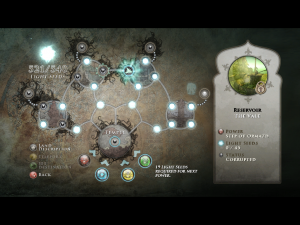Prince of Persia (2008): Structure and Freedom
I’ve probably been making Prince of Persia (2008) sound more linear and constrained than it is. Let me describe its structure more fully.
 The map is a highly symmetrical network of zones and passageways. The divisions between zones aren’t explicitly marked; it’s possible to go from one zone to another without realizing it. Each zone starts off in a state of darkness and corruption. In fact, “The Corruption” is the name of a sort of writhing slime that covers any surface that the level designers don’t want you to touch. And each zone has a special spot called “Fertile Ground”, consistently pronounced with a long i, like “fur tile”. When Elika does her sacred magic thing on the fur tile, a Genesis-Effect-like aura spreads out from it, restoring color, making grass grow, and permanently cleansing the zone of the Corruption. (The architecture is left in ruins, but you can’t have everything.) Cleansing all of the zones is pretty much the game’s main goal.
The map is a highly symmetrical network of zones and passageways. The divisions between zones aren’t explicitly marked; it’s possible to go from one zone to another without realizing it. Each zone starts off in a state of darkness and corruption. In fact, “The Corruption” is the name of a sort of writhing slime that covers any surface that the level designers don’t want you to touch. And each zone has a special spot called “Fertile Ground”, consistently pronounced with a long i, like “fur tile”. When Elika does her sacred magic thing on the fur tile, a Genesis-Effect-like aura spreads out from it, restoring color, making grass grow, and permanently cleansing the zone of the Corruption. (The architecture is left in ruins, but you can’t have everything.) Cleansing all of the zones is pretty much the game’s main goal.
The important thing to recognize about this is that the Corruption is a constraint on your movement. Entering a corrupted zone, you’ll find that you’re mostly confined to a single path. Cleanse it and your options open up. Which is a good thing, because you still have a good deal more to do there. The cleansing magic also makes glowy floating things called “light seeds” appear, turning the zone into a hunt for collectibles. And in this phase, the player has considerable freedom. Yes, you get the same visual cues as always for reaching them, but in some cases I’m pretty sure that I spotted and followed alternate routes to light seeds before I found the preferred one. Notably, light seeds that you collect while falling stay collected even if you get rescued by Elika. I don’t think the preferred route ever actually requires you to be rescued, but it’s a serious option.
Now, with certain exceptions, every zone in the map is open for exploration from early in the game. However, most of the fur tiles (and some of the light seeds) are in places that can only be accessed by means of special magical powers that Elika accesses one by one over the course of the game. There are four different powers, including flight and a power-climb that can take you across ceilings, but they all come down to the same thing: they all, in some way, transport the player from a special colored plate — the color determining the power — to a fixed destination. The plates are another assertion of authorial control: if you could just activate these powers from anywhere, the experience would be in the player’s hands, and we can’t have that.
So, how do you obtain these powers? By collecting light seeds. You get your first power at 60 seeds, the second at 170, the third at 340, and the fourth and last at 540. 540 is significantly less than the amount available, and (as far as I’m aware) there’s no advantage to collecting more after you’ve got all the powers, so obsessive completism is not required, unless you’re like me and just value 100% completion for its own sake. You do, however, need all four powers to complete the game, and that means a lot of hunting and backtracking to find enough seeds. Inevitably, you wind up crossing through zones that you can’t cleanse yet in order to reach ones that you can.
The interesting part, however, is that you can take the four powers in any order. Whenever you go back to the Temple to cash in your seeds, you get to choose whichever of the remaining powers you want. And the order in which you take them affects the order in which you can cleanse the zones. If you want to tackle a particular zone first, you can find out its required power (which is helpfully listed in the map screen’s zone data) and obtain that power first. You still ultimately have to cleanse all the zones, but there’s no particular ordering to them, even though there’s still a Metroidvania-like progression of decreasing constraint.
 Comments(0)
Comments(0)